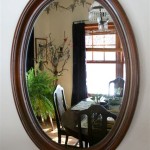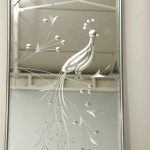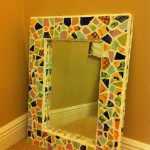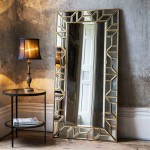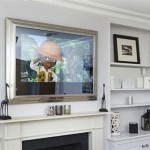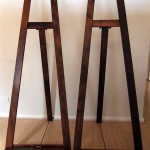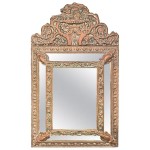Art Nouveau Mirrors
Art Nouveau mirrors represent a fascinating intersection of functionality and artistic expression. Emerging at the turn of the 20th century, these decorative objects captured the spirit of the era with their unique aesthetic, characterized by flowing lines, organic forms, and stylized natural motifs.
Key Characteristics of Art Nouveau Mirrors
Several key features distinguish Art Nouveau mirrors from other styles:
- Asymmetrical shapes: Rejecting the rigid geometry of previous periods, Art Nouveau embraced free-flowing, asymmetrical designs.
- Natural inspiration: Flora and fauna, particularly insects, flowers, and vines, served as primary sources of inspiration.
- Curvilinear lines: The "whiplash" curve, a sinuous, undulating line, became a hallmark of Art Nouveau design.
- Female figures: Representations of women, often with long flowing hair, were frequently incorporated into mirror frames.
- Stained glass: The use of stained glass, both as a primary material and as an accent, added color and texture to these decorative pieces.
- Handcrafted details: Many Art Nouveau mirrors featured intricate hand-carved details, showcasing the skill of the artisan.
Materials and Techniques
Art Nouveau mirror makers employed a variety of materials and techniques to achieve the desired aesthetic. Wood, particularly walnut and oak, was commonly used for frames, often carved and shaped into intricate designs. Metals such as brass, copper, and pewter were also popular choices, offering opportunities for both cast and hammered ornamentation.
Influence of Leading Designers
The Art Nouveau movement boasted a wealth of talented designers who significantly impacted the style of mirrors produced during this period. René Lalique, renowned for his exquisite jewelry and glasswork, also designed stunning mirrors incorporating stylized floral motifs and female figures. Émile Gallé, a master glassmaker, created mirrors featuring cameo glass, a technique involving layered and carved glass to produce intricate designs. Louis Comfort Tiffany’s innovative use of favrile glass, with its iridescent and opalescent qualities, resulted in unique and highly sought-after mirrors.
Art Nouveau Mirrors in Interior Design
Art Nouveau mirrors were integral components of interior design during the movement's peak popularity. They functioned not only as reflective surfaces but also as works of art, enhancing the overall aesthetic of a room. These mirrors were frequently placed above fireplaces, in hallways, and in bedrooms, adding a touch of elegance and artistry to these spaces.
Collecting Art Nouveau Mirrors
Today, Art Nouveau mirrors remain highly collectible items. Their beauty, craftsmanship, and historical significance appeal to collectors and enthusiasts worldwide. Factors influencing the value of an Art Nouveau mirror include the designer, the materials used, the intricacy of the design, and the overall condition.
Identifying Authentic Art Nouveau Mirrors
Given the enduring popularity of Art Nouveau, reproductions abound in the market. Discerning authentic pieces requires careful examination. Key indicators of authenticity include the quality of the materials, the craftsmanship evident in the details, and the presence of any maker's marks or signatures. Consulting with reputable antique dealers and appraisers specializing in Art Nouveau can provide valuable assistance in verifying authenticity.
Restoration and Preservation
Proper care and maintenance are crucial for preserving the beauty and integrity of Art Nouveau mirrors. Cleaning should be done with gentle, non-abrasive materials. Any necessary repairs or restoration work should be entrusted to experienced professionals specializing in antique mirror restoration. These specialists possess the knowledge and skills to address issues such as damaged frames, silvering loss, and stained glass repair, ensuring the mirror is preserved for future generations.
The Enduring Legacy
The influence of Art Nouveau mirrors continues to resonate in contemporary design. The movement's emphasis on organic forms, flowing lines, and handcrafted details can be seen in various modern interpretations, demonstrating the enduring appeal of this distinctive style. While contemporary pieces may draw inspiration from Art Nouveau, they often incorporate modern materials and techniques, creating a fresh perspective on the classic aesthetic.
Art Nouveau Mirrors as Investments
Beyond their aesthetic value, Art Nouveau mirrors can also be considered sound investments. Authentic pieces by renowned designers tend to appreciate in value over time, making them desirable additions to art and antique collections. However, the investment potential of any given mirror depends on a variety of factors, including its rarity, condition, and provenance. Researching the market and consulting with experts are essential steps for anyone considering Art Nouveau mirrors as investments.

Casa Padrino Luxury Art Nouveau Mirror Dark Brown 63 6 X 5 H 151 Cm Rectangular Solid Wood Wall Wardrobe Baroque Furniture

Casa Padrino Luxury Art Nouveau Mirror Dark Brown 157 X 12 H 71 2 Cm Rectangular Solid Wood Wall Bedroom Baroque Furniture

Art Nouveau Mirror With Tray Veronese Www Figuren De

Antique Big Doll House Art Nouveau Mirror Ormolu 1900

Buy Art Nouveau Architectural Mirror Frame With Lilies Floral Pierced Trim In

Large Art Nouveau Mirror Bei Pamono Kaufen

Large Art Nouveau Mirror Bei Pamono Kaufen

Vintage Art Nouveau Hand Mirror In Broe

Antique Mirror Gold Ornate Oval Art Nouveau Style Large Wall French Scalloped Entry Way Frame Victorian Mothers Day Gift Österreich

Large Art Nouveau Mirror Bei Pamono Kaufen

